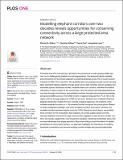| dc.description.abstract | Protected area (PA) connectivity is pivotal for the persistence of wide-ranging wildlife species, but is challenged by habitat loss and fragmentation. We analyzed habitat suitability and connectivity for the African elephant (Loxodonta africana) across PAs in south-western Tanzania in 2000, 2010, and 2019. We quantified land-use changes through remote sensing data; estimated habitat suitability through aerial survey data, remotely sensed variables and ensemble species distribution models; modelled least-cost corridors; identified the relative importance of each corridor for the connectivity of the PA network and potential bottlenecks
over time through circuit theory; and validated corridors through local ecological knowledge and ground wildlife surveys. From 2000 to 2019, cropland increased from 7% to 13% in the region, with an average expansion of 634 km2 per year. Distance from cropland influenced elephant distribution models the most. Despite cropland expansion, the locations of the modelled elephant corridors (n = 10) remained similar throughout the survey period. Based on local ecological knowledge, nine of the modelled corridors were active, whereas one modelled corridor had been inactive since the 1970s. Based on circuit theory, we prioritize
three corridors for PA connectivity. Key indicators of corridor quality varied over time, whereas elephant movement through some corridors appears to have become costlier over time. Our results suggest that, over the past two decades, functional connectivity across the surveyed landscape has largely persisted. Beyond providing crucial information for spatial prioritization of conservation actions, our approach highlights the importance of modeling functional connectivity over time and verifying corridor models with ground-truthed data | en_US |

